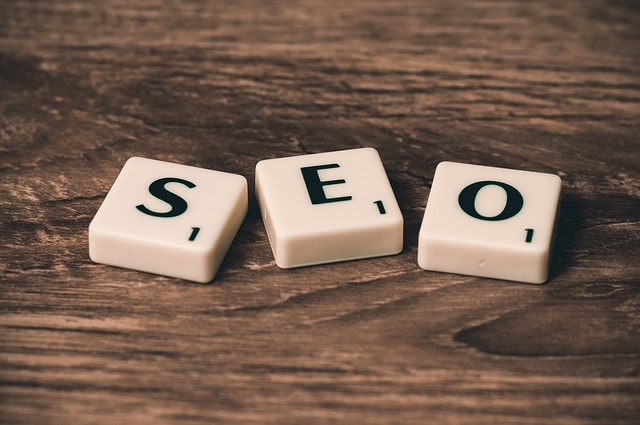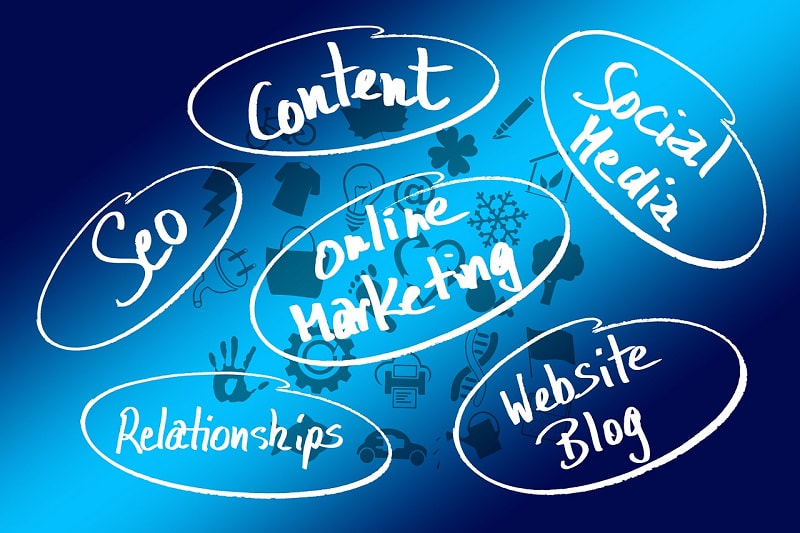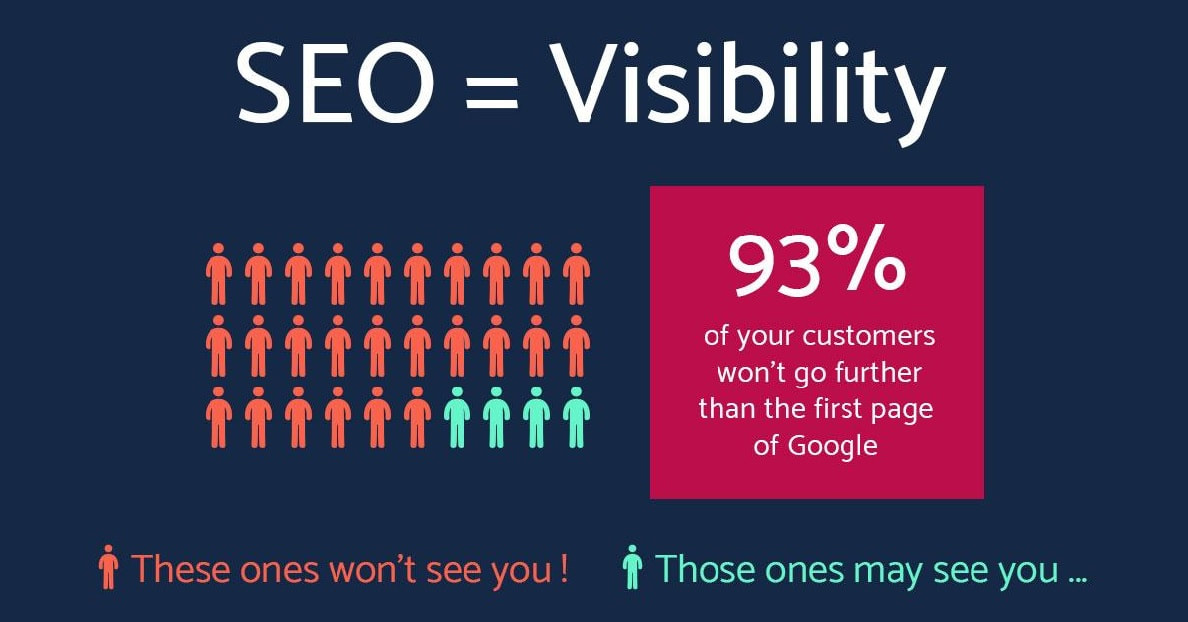|
If you have a website, you should be looking for ways to rank well in search engine results. But with millions of websites competing for attention, you may feel like you're playing a lost battle. What if we told you that it's easier than you think? Some simple yet effective strategies can majorly improve your website's search result ranking and here’s how.
0 Comments
The internet world is fast-paced, with countless websites vying for attention. While numerous tactics can help your website grow, there's no denying that SEO (Search Engine Optimisation) is the ultimate power player. However, there are some essential do's and don'ts that can make or break your online presence. Let’s dive right into them!
In today's digital age, having a website is pivotal for businesses, organisations, and even individuals. It's your online presence, digital storefront and a means to connect with your audience. Because your audience can't meet you in person, it’s the way in which you make your first impression on them.
However, building a website is not as simple as it may seem. Numerous pitfalls can hinder your site's success. But the good news is: they’re all easily avoidable! So, let's explore some common errors you should steer clear of when creating a website. Search engine optimization (SEO) is one of the most popular digital marketing strategies used today, as it allows you to boost your online visibility and gain organic traffic. Whilst there are many ways to implement this, your site content will be a key area to focus on since this will help you attract users and gain credibility.
As they say, content is king in marketing, and the same principle applies to SEO. So, to make sure that you always deliver fresh content to your audience, why not start a blog on your site. Check out some of the top SEO benefits of doing this, and it may convince you to give it a go. If you are in the business of selling products or services, then having a local search listing is essential. These listings will provide your customers with information about where your business is located and what it offers. If you have never considered getting a citation before, now may be the time to do so because they can help increase traffic to your website. Read on for more information about these listings and why they are important for businesses like yours.
Are you failing to get leads from your website? Does it feel like a ghoul has hijacked business leads? Are you scared about this ever-changing world of digital marketing? Well, Perfect Layout are here to rescue you from your nightmares as we explain how Search Engine Optimisation (SEO) works. If you put in place these strategies, you will see your ranking improve. Are you ready to handle more leads coming to your business?
If you’re serious about wanting people to find you through a Google search, Search engine Optimisation (SEO) must be at the top of your priority list. For example, you you're a structural engineer looking for people planning major works to their property, you want to be sure that you website can be found. If you have a well-crafted website that your company has spent time and capital on, it won’t give you the returns you are looking for if you ignore search engine optimization (SEO). Without SEO, your website may as well be invisible.
Today, SEO is the primary way most businesses attract customers. If you are a bit confused about what SEO is and how it works, this blog explains one element that most businesses can put into action tomorrow. Great on-page content containing relevant keywords will work towards helping your website rank well on a results page for search engines such as Google and Bing. It's a new year, and most of us are hoping for better things in 2021. Are you seeking to improve the SEO for your online business this year? Whatever your answer, it's wise to update your search engine optimisation (SEO) knowledge because the way SEO works means that it’s a constantly changing entity. Keep reading to see how one or all of these tips could form part of your strategy for improving your SEO.
SEO Stands for Search Engine Optimization and basically refers to the processes that are followed when it comes to optimising (getting the most out of) a website to be ranked by search engines. The most popular search engines on the internet are Google, Yahoo, Bing and Microsoft.
When a website is designed and developed, it should represent more than just a portfolio of your products and services. After all, what’s the point of having a website that looks awesome, but goes unseen by the people that would like to buy your wares? SEO is the technical part of marketing online as it helps your website get promoted to the correct location – right in front of buying customers. There are various techniques used to get more traffic to your website from search engines, which can be broken down into two categories. Off-page SEO, is the work undertaken externally to a website and on-page SEO are the changes made on the actual website. If you are struggling with your online presence and aren’t quite sure about how to improve things, one positive action you can take is undertaking a review of your Google My Business (GMB) profile. But what’s a GMB, I hear you ask?
They are the short lists that pop up when you search for something generic like “cafes near me” or when you enter a specific business name, the GMB listing can appear. Businesses registered with a GMB can also appear on google maps. This platform can improve your online presence because it allows your business to be seen by the right people searching for you and could ultimately lead to you getting more leads. Setting up an account is easy. Google will send you a postcard with a verification code which helps them confirm you are located where you claim to be at and not across the sea. Once you have been verified, you can go about optimising your profile. Have you considered starting a blog for your business but you’re not quite sure if it would be of benefit? You're aware that creating a regular blog will take up your precious time and you aren't sure if it is worth the effort? Well today, we’re hoping to dispel your worries and explain to you how a regular blog can help your business in a number of positive ways.
You don’t have to be a website designer or developer to know that when lots of people visit your website, that’s a good thing. It means that you are offering potential customers services and/or products that they want to buy or hire.
But (yes, there’s always a but…) getting people to your site and opening doors for them to peruse is not an easy objective to attain. The online market is saturated with services like yours and finding unique ways to stand out gets increasingly difficult, year on year. Back in 2017, we wrote a blog that outlined actions that would result in your website bringing in more business. Three years on and those principles remain the same…
To ensure that your website delivers more business to you, here are 10 effective steps that you can take. 1 - Mobile Friendly Design In April 2015, Google announced that it would favour websites that are “mobile-friendly”. Companies that are not investing in new websites, could see a decline in their business leads as their websites fall down the rankings. A responsive web design ensures that no matter what device someone uses (i.e. tablet, laptop, mobile phone) your website is displayed on the screen in the most effective way. No longer should mobile phone visitors see a website that is used for standard desktops, like a laptop, which can make viewing content, navigating menus and clicking on links difficult and awkward to use. Improving the online visibility of your business, is something that every serious business owner should be thinking about. The bottom line is that Increased visibility, equals to more customers visiting your business and thereby offering you more opportunities to make money. The following details was originally written by us in 2017. The blog was called , 'Four simple ways to improve your businesses visibility'. It gives bite-sized options of what actions you can start taking today without making you feel overwhelmed. So what are you waiting for? Whether you’re a small start-up business or an established company looking to increase your profits being visible must be one of your primary objectives if you want to achieve this goal. Spreading the word about what you do, the service you provide and the products you sell can be done in a variety of ways and advertising in print still a popular option. This can be accomplished through: - Placing an advert in a newspaper or directories like Yellow Pages or Thomson Local - Distributing leaflets through letterboxes - Putting up your flyers in local supermarkets, newsagents, coffee shops and community centres If you have a shop on your local high street, you will continually be advertising your brand with your logo above the door and your wares in the front window. But how many of us have a traditional shop front to be visible to passers-by? The fact is, the way we shop is changing with an increasing number of high street shops going out of business every day. In 2016 there were a reported 15 shop closures a day across the UK and online shopping is one of the factors contributing to this outcome. With the demise of the traditional physical shop and the increase in businesses going online, the way one advertises a business has transformed. Having an online website window can offer far more sophisticated ways to reach an endless, much broader, supply of customers potentially from around the world. If directly reaching out to like-minded businesses isn’t your thing, or if talking to friends, family and strangers fills you with dread, one option (to start you off gently) is to go to a conference. They are full of people open to being spoken to, having an exchange of ideas and maybe most important of all - exchanging contact details. Who knows, you could be talking to the next Bill Gates! The Perfect Layout team recently attended the free Mums Enterprise Roadshow event in London and we were delighted to see how many people attended. There were numerous stands offering various services and franchises and talks given by industry experts every half an hour. It provided the perfect opportunity to have a chat with other aspiring individuals who were keen to follow their passion and soak up as much information as possible. Whilst the topics were of a preliminary advisory level, looking beyond this, it was a brilliant place to do some networking and get our name known! Online social networking involves working from social media platforms such as, Facebook, Twitter and LinkedIn. If you have something interesting and unique to say about what you do, then use these methods to get your message out there. As long as you stay within the terms and conditions of each social media platform, you will be able to attract new and repeat customers through what you say. You can also run advertising campaigns, gain followers and engage deeply with your customers and get to know them. They then ‘like’ or recommend what you’re offering, your credibility and reputation grows and so will your visibility and profits. The cost for using this method is mainly your time. You really do get out, what you put in, so make the effort (or hire someone to do it for you!) and start writing. Also known as Pay-per-Click (PPC), it allows you to be seen above your competitors when a search is made using keywords related to your business. A big plus is that you can track the number of clicks people make on your advert, measure the cost and pay Google only made when a customer visits your website. The cons of undertaking a Google AdWords campaign are that you need to really understand your business, your customers and, to a certain extent, how the internet works. For example, what words will people use when searching for your business? Choose those terms and then you can set your budget. If you have numerous search terms then your budget will need to be set accordingly. It may take a while to see a return on your investment (ROI), but over time, with some tweaking, this can be achieved. They all help increase your visibility when search engines like Google and Bing, crawl the internet looking for sites that your website is linked to. If your business is cited on these directories, the search engines will see this and view you as being more trustworthy and credible than someone who isn’t listed. The result – your rankings improve. It’s important to gauge the type of things your audience may want to hear about against your ability to provide them with interesting ways to share your expertise. So, get creative and start writing about how the life of your business can add value to the life of your customers. So, step out of your comfort zone and try one of these techniques. If you want your business to be more visible online you must develop ways of reaching your customers. If investing in social media platforms isn’t your thing, then take the time to master something else first. You’ll probably surprise yourself with your own creativity and ability at thinking outside the box. The more confident you become, the more skills you’ll attain and the more your business will benefit. If you'd like a chat any of these tips why not give us a call on 01708 578 015 it would be our pleasure to help you! 1. Keep it Fresh. Your website content must be fresh, trustworthy and informative. Search engines like new content so you have to keep your website regularly update. Don't create a website and just let it sit there forever.
2. Generate Organic Traffic (Part A). This is part of your search engine optimisation (SEO) strategy and first you have to know and plan your keywords. Keywords are the words that people type into a search engine to find something on the internet. A keyword can consist of a single word, such as "bike" or an entire phrase, like "mountain bikes for beginners". 3. Generate Organic Traffic (Part B). Keyword placement is important. Make sure your 'title tags' (the words you see in your browser window) have your keywords in them. This is what search engines use for the title display in their search results. 4. Generate Backlinks. This where other internet sites link to your website. They are important because search engines look at the number and the level of quality of websites that connect to your website to determine how your page may rank on their listing. One of the most common ways of finding backlinks is in trading links with other websites. 5.Article Marketing. Article marketing is a technique to generate quality backlinks to your website quickly and easily. Each article will have an author's resource information box that is attached to your article submission and you can refer readers to your website. 6. Use Feeder Sites. A feeder site is a third party website that allows you to place content on its webite. Search engines like feeder websites and there are many feeder sites online that you can use to siphon traffic from the search engines to your website. 7. Video marketing. It is easy to submit a video to YouTube and some of the other video sharing websites. Add your site's URL to the video itself, and add a link to your site in the description of the video, too. This will help generate traffic, especially if you target keywords with your video titles! 8. Paid Traffic. Pay Per Click advertising is paying for your website to be at the top of search engine results when a person types in the keywords that best describe your product or service. The higher you bid, the higher your link will be displayed in the list and you only pay when a somebody clicks on your link. 9. Employ a specialist web design / search optimisation company. They can apply methods to get your website near the top of the search page. Employing a specialist to generate traffic will cost you money however their graphics, knowledge and input will be search friendly. 10. Remain Consistent. In order to maximise the performance of all of your traffic campaigns you need to stay consistent, adding fresh new content to your websites and consistently maximising exposure so you keep the momentum going. If you would like help getting your website ranking on page one of Google, get in touch with our team on 01708 578 015. If you thought that GMB was shorthand for a trade union, think again! In the modern age it’s much more likely to be a reference to Google My Business. You may feel that people “google” your business all the time, but do they always find you? Google’s free product Google My Business (GMB) is incredibly useful for helping people discover you and for putting your name on the first page of search results. So, yes you do want to be on Google My Business. How does GMB work?You’ve probably seen hundreds of Google My Business listings without realizing it. They’re the short lists that pop up when you search for something generic like “cafes near me” or often when you search for a specific business name it’s the GMB listing that appears. Below is an example of a “cafes near me” search. Each one of these businesses will have a GMB listing. You’ll see that a list of 3 names appears, this is what Google calls the “3 pack” When you click on one of the named business it will take you through to their individual GMB listing, containing more information including a location map and often a photo, video, blog and lots of useful info. This information can satisfy searchers, but most will then click through to your website using the button at the top of the listing, especially if you have lots of products and services. A café for example would likely have menu details on their site. GMB is therefore essentially a widely used local business listings service, used by large and small companies. The great news is that every business can achieve a prominent listing if they get the basics right and deliver great value that customers appreciate. The top 8 Reasons you need to be on GMB1. Achieving prominence in search results A listing can help your business to stand out in search results, and can help people to find your business, whether it’s online or offline. Your objective should be to get into the top 3 search results, which is where factors such as review scores are important. 2. Local search for local services If you want to improve your chances in local search results, then a GMB listing is the key. Research shows that 46% of all searches are for local businesses while the “3 pack” format of results now appears in 93% of all local searches, so you have to be there! 3. Searching on your mobile Most local search is now done on smart phones and GMB listings dominate mobile search results. 4. Make it easy for customers to find you GMB listings provide a quick snapshot of your business. Maps, opening times, images and reviews all help searchers quickly decide whether they should visit you. 5. Think about your competition If you’re annoyed that your competitors always appear in searches and you don’t, it’s because they have a GMB listing. Something as simple as that will mean they’re getting some of your business, unless you get on GMB yourself. 6. Gives you credibility Users are accustomed to seeing these profiles, and it can lend some credibility to your business. Listings look professional and provide key information that helps people to decide whether you’re a credible business or not. 7. GMB has amazing features Google are constantly updating their GMB features, so you can now add all kinds of fabulous elements to your listing, not just photos but videos too. Videos are a great way of educating customers and really help them make buying decisions. As with everything on the internet it pays to keep your GMB listing fresh, so make sure to add seasonal special offers, events information, and to add regular blog posts. They all help in making you easier to find and to ensure you appear in the “3 pack”. 8. Free and Easy Google My Business is free and easy to set up, but if you don’t have the time or feel you don’t have the skills it’s second nature to our digital whizz kids at Perfect Layout. If you are unsure or don't have the time to set up your GMB, give us a call, we can help you get your business visible online. We are asked all the time, why do I need a blog on my website? It probably ranks right next to, what is SEO? And believe it or not the two are related. In a nutshell the number one reason for having a blog on your website is that it drives search engine traffic. How does it drive search engine traffic? Well, for one it enriches your content, but secondly and of equal importance it keeps your site updated. If you think about the way Google and other search engines work, they constantly look for indexed pages. So every time you put up a blog it’s one more indexed page on your website, which means there is a greater opportunity for it to show up in search engines. Blogging also shows search engines that your site is active and they should be checking back regularly for new content, even better it puts more keywords on your site, all of which help it rise up the page rankings; in the trade it’s known as organic SEO!  But it’s not all about SEO. Blogging is one of your best sales tools that can help increase leads and improve conversion rates. While its pretty tacky to use your blog for a direct sales message, it is your big chance to really tell your organisation’s stories. It will also show your credibility and to prove your authority in your market. In many ways blogging is your chance to show off and to really convey that you are an expert in your field. We always get a real buzz when we read a blog that teaches us something new, written by someone passionate about their subject, it’s such a great opportunity to get inside the personality of a business. Don’t make it too long though (around 500 words is optimum), but tell compelling stories in your voice which help customers and potential customers understand something about what you do, how you work, your industry or what you’ve learned on the way. Your blog therefore is the enrichment you put into your site, the thing you do to change it from a showroom into a friendly business. The big benefit of this rich content is that readers love to share new, fun and interesting material they’ve found online. Which means that not only do you have something to put up on your social media channels every time you blog, but so do your clients and potential clients. Think about it, if a potential client has read your blog and has even linked to it on social media, how much more likely are they to buy from you than if all they’d seen were the static “services” or “about us” pages on your website? You know we said its not all about SEO, but actually those social media links are great for creating inbound links to your website, something search engines absolutely love. As you can see we practice what we preach, believing passionately that blogging is the most creative way for driving search engines to find you and to influence prospects to buy from you. If you need help with making this happen, why not get in touch on 01708 578 015 or take a look at our copywriting services for more information. Today more than half the media we consume comes through digital channels. Reaching consumers through digital channels offers various advantages and today we will discuss five of those reasons. In 2019, no business wanting to succeed can be without a digital strategy. It should be a fundamental part of all businesses to produce, publish and distribute content which allows them to expand awareness of products and services through digital channels. It takes money to make money. If you want to expand your brand, increase sales and grow your business fast, then it is important to invest in marketing for it to happen.
Offering a sale during a festive season in a certain area, can be an example of location-based targeting. Example: A Sandwich Bar can post google ads during rush hours to working class people at 4 PM around 6 KM diameter of the bar. Reason 2 - Visibility in the Online World All potential customers have moved online where they are actively searching for products and services. Unlike the traditional form of marketing, Digital Marketing has the capacity to reach the right audience and also engage with them in various forms of communications. The more you penetrate online the more you can motivate the customers to take action, which generally leads to a better Return of Investment (ROI). Nowadays, there are various platforms in which businesses can be listed. Using social media, directory listing services like Google Maps, Trip Advisor and Yelp can help to increase the brand visibility on the internet. Search Engine Optimisation plays a huge role in the organic side of visibility. Placing Ads on Google or social media are other ways to help increase the visibility of the brand.
Reason 4 - Fast, Effective and Low-Cost Unlike traditional media, digital marketing is able to penetrate the market quicker. Campaigns can be effective when applied with great marketing vision. When comparing costs, it’s more likely to be much cheaper than traditional medians such as directory, print, radio or TV advertising. Businesses can market their services with better effectiveness and at a lower cost. Reason 5 - Measurable Digital marketing campaigns are measurable and can be segmented in metrics to create a meaningful output. The output can be further analysed, in order to optimise further campaigns to create more efficient results. Some of the tools used for Digital Marketing are Google Analytics, Google Ads Platform, Facebook Analytics. An example of how analytics can have an effective impact on a business is demonstrated by this example…A barbershop decides to put a store ad to Facebook. He creates an ad which ran 24h every day. After a few weeks, he looks at the analytics and finds that the peak hour of the clicks in the ads are during the day from 12pm-4pm. Now, he edits his campaign so that the ads run with more budget during these peak hours, and less or not at all outside of these time frames. This way the barbershop used the power of Digital Marketing to successfully give him an increase on his Return of Investment (ROI). Get in touch you if require help with your marketing strategy by emailing us, or calling 01708 578 015. Organic SEO or search engine optimisation is one of the most powerful online marketing strategies available to webmasters and bloggers. It takes a combination of high-quality content, social media presence and other factors to climb to the top of the search engine rankings for your specific keyword phrases. Without the right ingredients, your SEO strategy can actually backfire. It all starts with the keyword phrases and the theme of your content. Without unique, high-quality content, you will struggle to find your website or blog listed on Google, Bing, Yahoo or any other search engine. According to Optimonster these are the most important SEO ranking factors:
Below, you will find the top five organic search engine optimisation techniques and a few tips to help you gain a larger web presence. SEO is no longer a world dominated by the website receiving the largest number of backlinks. Good content Content matters and it must be high-quality content. Low-quality, poorly written content doesn't rank very well because it doesn't provide the user with a great experience. The goal of Google and all other search engines is to deliver the best possible search results for their users. High-quality, usable content provides the type of experience internet searcher want. Most searchers seek information, such as a solution to their problem or a how-to type of article about something specific. When your content delivers this type of experience, you gain higher ranking on the search engines because they consider your content to be high in quality. Use videos or images Not all content requires a video or an image, but the use of both or at least one can greatly aid in ranking higher in the search engines. Images provide away to break up your content, give the user something to draw them in and give you the opportunity to increase your on-page SEO. Whenever you provide a relevant image with your written content, you can change the ALT tag and the image title to match your theme. By using your main keyword phrase or a secondary keyword phrase as the ALT tag and title of your image, you score extra SEO points. Images also provide a second benefit. Google and other search engines will list the images in the "image" search category. This means, when somebody is searching for an image and they find yours, it could potentially lead them back to your website. However, if you don't provide an image title or ALT tag, you may not get listed. Videos are another very powerful way to deliver content. Providing a video with your written content gives the visitor a better experience, as long as the video fits with the content. This is a very powerful way to build better organic SEO. In addition, videos tend to gain higher ranking on Google than some written content does. We can constantly find out more concerning techniques for organic search through correct searching. Create a blog Websites without a blog can still rank high on Google, Yahoo and Bing, but they are missing out on one of the most powerful organic search engine optimisation techniques online today. Blogging provides the ability to target a broader subject area and cover very narrow topics within the broader spectrum. Every blog post acts as a small traffic engine and provides the opportunity to gain more traffic from the search engines. Think of blogging this way, when you post high quality content to your blog, it's like deploying an army of individuals with a stack of business cards. Each blog post will go to a different corner of the internet and attract a different type of individual to your website. Not only can the blog posts take over first page ranking on the search engines, but they also help you build a community. If your blog post covers topics somebody is interested in, they will subscribe to your blog. When somebody subscribes to your blog, you gain multiple opportunities to sell your products and services to them. Use social media Social Media is not going anywhere and it is important to be present on all relevant platforms.Google and other search engines track the networks that your business is connected to. Social signals factor heavily into organic SEO and if you want to rank high for your target keywords, you must use social media and social bookmarking. Sites, such as Facebook, Google+, Twitter, Pinterest many others offer great leverage if a business is looking to increase their organic search engine optimisation. By sharing blog posts across these social media sites, gives you the ability to increase organic search and gain social traffic. Meta tag your website
Your META title, description and tags are really important to your overall SEO. Search engines use the meta data to better understand what your page or post is all about. When a search engine creates your listing, the meta data is used for the title and description showing up for your page or post. With the right title and description, you improve your SEO positioning. Now that you know five of the most important techniques to help you get organic search traffic, it’s time for your to take action. This is not an overnight job, it takes a strategy, a plan and then dedication to keep it up regularly. If running your business is taking up all your time and you need someone else to manage your organic search traffic for you, contact the team at Perfect Layout on 01708 578 015. According to emarketer approximately $11.5 billion was spent on online video advertising in 2018. There is no getting away from the fact that there is now an expectation from consumers to view the products and services of a business in a different format. Those in the know, have incorporated some of their advertising and marketing budget to attract customers by using this method in different ways. The reason for the rise in video advertising becoming more popular is its effectiveness. If a picture is worth a thousand words, a video is worth much more. Forrester estimates that one minute of video equates to 1.8 million words of text in the message communicated. That’s an amazing statistic!
Research shows that four times as many consumers would prefer to watch a video about a product rather than read about it. Video content already represents 76% of all Internet traffic and projections estimate 80% of all Internet traffic by 2019 will be videos. The same study states that using the word ‘video’ in an email subject line boosts open rates by 19% and clickthrough rates by 65%. Video on a Landing PageWhen a visitor lands on your site, you’ve literally got seconds to impress them and get them engaged with what you have to offer. This is the whole point of a landing page. But these days, people are so used to seeing rich media content on the internet that, quite frankly, text content often doesn’t keep them engaged. Embedding a video on your website will not only increase the length of time that visitors stick around, but also, the number of conversions to paying customers, which, ultimately, is what SEO is all about. Cons of using videos on a landing page 1. A low-quality video or poor video execution could possible cheapen your brand and offering 2. A video can be an overkill or a distraction when it's too long 3. An autoplay video might be annoying for users if the website is visited frequently by your prospects and customers. 4. In some instances, an image (meme, infographic, etc.) can be more interesting than a video, especially if your target demographic is less inclined to pay attention to videos. 5. Producing top-quality marketing videos will require hours of learning a new skill set. There are many different types of video content you can use. To give you a flavour of the different types on offer – here is a short list explaining some of them: Demo VideosDemo videos should teach prospects or customers how to accomplish something with your product. It’s not a 1 hour demo caught on camera, but a quick overview of one or more of your features. Keep your demo videos to the point, walk viewers through one action, and do it succinctly. Brands need to create extraordinary video to earn attention, likes, and shares. The video should reflect the business ideology and style in a short and effective way. Event VideosEvent Videos Most event organisers have recognized how important video content is in making people aware of an event. Event videos communicate impressions of the event and transport emotions. Educational VideosEffective educational videos are driven by emotion and backed by facts. Our brains process visual information 60,000 times faster and the use of sound and visual cues increases enjoyment and retention.Video puts us in the room where it happens, which makes it particularly effective in education as it creates context and puts learners at the centre of the action. Explainer VideosObviously, not every business with a website has a product to sell, as some businesses are service oriented. For these, you can increase conversions with the use of explainer/introductory videos. There are varying styles for these videos, and truthfully, there’s no exact science as to what styles work best. It’s more about producing a video that explains/introduces a client’s business effectively and in an engaging way. Animated VideosAnimated video brings concepts to life that text or live videos can’t. Think about it the world really is your oyster where you can make your characters talk all you want, fly, or travel in time. With the help of animation, you can show how mechanisms and processes work in an interesting way. Case study VideosRather than focusing directly on your product or service itself, a good case study tells the story of your customer from their point of view and how your business helped to solve their problems. All of this builds the credibility of your brand. Social proof is another reason why case studies work so well. It’s a psychological phenomenon that means people are more likely to take certain action if they see others taking that action also. Testimonial VideosIf you’re hosting or participating at an event, that means your customers are likely to be there too. Take advantage of the opportunity and get them on camera to create customer testimonials full of passion for your brand. Attendees can also be interviewed on what they are enjoying and learning to get more people to attend your corporate events in the future. This list is just a snapshot of what can be done to help sell your product or service via video. If you need help with incorporating this marketing idea into your digital strategy – give us a call today on 01708 578 015. Online Marketing is the method to deliver promotional content through the internet to the people’s browser or email. Online Marketing can be done by text ads, image ads, video ads, native content or from Apps like Facebook or Twitter and many more. Online Marketing allows you to reach people you may not reach with offline marketing campaigns. Search Engine Optimisation (SEO)Search Engine Optimisation (SEO) is a practice of increasing the quantity and quality of traffic using various strategies, techniques and tactics to obtain high ranking in organic [Unpaid] search results. In other words, SEO is a process of making web pages attractive to the search engine such as Google, Bing or Yahoo. SEO can be done by editing on-site and off-site elements of the website to improve the chances of showing up higher in Search Engines Results Page (SERP) for important keywords. According to Hootsuite, Google holds 76% of the total Search Engine market share while 93% of people click on the search results in the first page of Google. Search Engine Marketing (SEM)SEM refers to paid search marketing in the search results. We can define SEM as serving an advertisement to a user using a search engine based in their query. For example, for a user who searches for a query, we can bid on certain keywords which match algorithmically to the user query and serve a text ad to them. Search engine marketing has grown exponentially over the past decade. Google AdWords is the most popular paid search platform used by search marketers followed by Bing. Social Media Marketing (SMM)Social Media Marketing is a method to increase traffic and promote your content, product or service using social media platforms like Facebook, YouTube, Instagram, Twitter or other social media apps. We can term Social Media Marketing as the process of using the potential of social media to leverage the value of your business. Out of 4 billion internet users, 3 billion people use social media. So, the power to networking and publishing through social media is high. Pay-Per-Click Advertising (PPC)PPC stands for pay-per-click. It is a model of online marketing in which advertisers pay a fee each time one of their ads is clicked. Essentially, it’s a way of buying visits to your site, rather than attempting to 'earn' those visits organically. The advertiser pays publishers every time a visitor clicks their ad, hence the model is known as pay-per-click, as advertisers only pay when the visitor clicks their ad. If a visitor sees an ad but doesn’t click it, the advertiser is made aware of the impression but doesn’t have to pay as no click took place. Content marketingContent Marketing is promoting free or additional value to your targeted audience or users that you already have. Good content either should provide information [that the user is looking for to solve the problem], inspiration [So people can get inspired to buy or use the product service to solve the problem.] or entertaining so that user will stick to the content for better click through rates. Writing a blog, making video contents, creating a podcast can be few examples of Content Marketing. Affiliate MarketingAffiliate marketing is monetisation of word-of-mouth marketing. It is a way of getting a commission in exchange for referring a product or service to another customer. Affiliate marketing has evolved over the past decade as the internet has evolved and a number of channels such as social or email etc. Basically, it is influencers that are recommending products and services that are not their own, but people go to them to get the information. Email MarketingEmail marketing is a workhorse of digital marketing as you can deliver a highly personalised experience, multiple times on a scale through email. The main advantage of an email marketing is that you precisely know how many emails have been delivered, opened or clicked upon. Tying up these numbers with revenue metrics, the numbers will have a big meaning to your email marketing campaigns. Example of email marketing can be sending promotional emails, email with offers or discount or thanking customers or users for using the product or can be used to provide inspirations to try your product or services. Some of the popular automated email marketing tools are MailChimp, Constant Contact, drip and convert Kit. Nowadays it’s plain to see that a massive part of our marketing strategy is undertaken digitally. Consumers and businesses spend more time searching online than anywhere else, so that's exactly where your business needs to be in order to reach them. Whether you have been in business for a while or your business is in its infancy, the ever-changing picture of digital marketing can quickly grow and feel overwhelming. As a self-employed business owner, you are already faced with a long daily to-do list. How are you supposed to create, and maintain, an effective digital marketing strategy too? What is a digital marketing strategy? Your digital marketing strategy encompasses a series of actions (that take place online) with the aim of marketing your business and attracting the right customers. The term ‘strategy’ might seem frightening but simply means, ‘plan of action’. Creating an effective digital strategy doesn’t need to be scary and should be viewed as a necessary tool that's used for bringing more paying customers to your business.  Allow your business to grow and branch out Allow your business to grow and branch out How to build a comprehensive digital marketing strategy You will gain a better insight into your sector by studying other business models and reviewing the approach taken by your competitors. The results can form part of your strategy. The following is a list of other factors to consider when devising your strategy. 1) Identify and build your buyer personas Buyer persona's shows your ideal customer and can be developed by researching, surveying, and interviewing the target audience of your business. It’s important to note that this information should be based upon real data. Making assumptions about your audience can cause your marketing strategy to fail. To get a rounded picture of your persona, try and include information that relates to their demographics, motivations, behaviour patterns and goals. Include a mixture of customers and people outside your contacts database who align with your target audience.  2) Identify your goals and the digital marketing tools you’ll need Your marketing goals should form a significant part of the objectives for your business. For example, if your business’s goal is to increase online revenue by 20 per cent, your goal as a marketer might be to generate 50 per cent more leads via the website than you did last year to contribute towards that success. Whatever your dominating goal is, you need to know how to measure it. The success of a digital strategy will be measured differently for each business and will vary dependent upon the nature of your goal. Having the ability to measure the impact of a marketing strategy is essential as it will allow you to refine your approach accordingly. 3) Evaluate your existing digital marketing channels and assets. Which ones are you using? Should you be on others? The digital landscape changes quite often, so it’s a good idea to do your homework and find out what is out there, who is using it, why are they using it and if it’s a method that will fit in with your business. Not all platforms or assets are right for every business.
The key is to build a plan of what you would like to do and how you are going to achieve this. Can it be executed with your current resources or do you need to invest in more staff or external help? 4) Audit and plan your owned media. Your owned media (original content that you create yourself) is often placed at the heart of digital marketing – your website. Each element of content that your brand creates, such as your website pages, product descriptions, blog posts, e-books, infographics, all helps transform your website viewers into leads and customers. It can also boost your search/organic traffic. Whatever your goal is, you’ll need owned content to form part of your digital marketing strategy. You can then use other platforms (e.g. social media) to broadcast your messages to other audiences. 5) Create a content strategy and develop your earned media Earned media is external publicity that you haven’t paid for. This is media exposure that comes to your business via methods such as, customer reviews, or content that has been shared, reposted, or mentioned by other people on their social media channels. A good content strategy creates earned media. In turn, this exposure gets picked up by search engines and works towards them favourably ranking you above your competitors. Review the digital marketing asset column above and consider which tools will help your business receive more engagements and improve the external publicity for your site. 6) Do you have a budget for paid media? If you have a marketing budget, you may want to spend some of it on advertising. Branded content, pay per click advertising (PPC) or display ads in print/online newspapers/magazines are all varieties of paid media. Budgets can be spent easily, so choose wisely where you want to spend your money. For online businesses, this is an essential aspect of revenue growth and building brand awareness.  7) Bring it all together. It’s never too late to start implementing a good digital marketing strategy for your online business. A combination of owned, earned and paid for media can often give you better results. Remember to plan ahead (as much as is realistically possible) and schedule regular meetings to evaluate the impact and performance of what has gone out. What lessons have you learned? Going forward, does the marketing plan you have in place need to be tweaked? Digital marketing checklist: - Profile of your buyer persona - One or more marketing-specific goals - An inventory and audit of your existing owned, earned, and paid media - An owned content strategy plan - Social media marketing plan - Ideas of how you can create earned content - A budget and plan for paid for content (advertising) Have you got everything covered? We’d love to hear how you plan and action your digital marketing strategy. Leave a comment below to get the discussion started. Whatever type of business you have, there is no getting away from the fact that people will expect you to have an online presence. Whilst some business owners are able to make a reasonable income via social media platforms (like Facebook and Instagram) or e-commerce platforms (like Etsy and Shopify) having your own website has many benefits. If your budget limits you from hiring a website designer, or you are attracted to the idea of creating a website yourself, there are many website providers to choose from. They will advertise low-cost packages with guidance on how to do it yourself, but will the end result generate more customers coming to your site? Five top tips to having a great website  Top tip 1 – ensure that the content on your site accurately reflects the services/products of your business. Your bounce rate will increase if your writing style includes over long sentences, has grammatical mistakes or has a dull/flat tone. Analyse your competitors and review what does and doesn’t work for them. Let your website reflect your personality and the type of business that you have so that you don’t come across as cold and boring. Brainstorm the terms that your customers search for you. Googles keyword planner is a tool that can help you pinpoint relevant long and short tail keywords. Having relevant keywords allow search engines, like Bing and Google, to match the right business to the right customer. We understand that creative writing is not everyone’s cup of tea, so if the thought of doing this doesn’t sit well with you, why not give us a call? We have an excellent copywriting service that can be accessed in isolation or as part of an ongoing package. Top tip 2 – be sure to encourage your conversion rate by giving those perusing your site every opportunity to get in touch or make a purchase. Using Call to Actions (CTA’s) throughout your website are a great way of nudging customers to act. CTA’s can be contact forms, telephone or current special offers.  Top tip 3 – gone are the days when all websites were difficult to view on a mobile phone. Business owners on platforms that are not mobile friendly will be penalised by search engines, which could negatively affect your rankings. When creating your site, make sure it has the ability to respond to the device (mobile phone, laptop or iPad) that is being used. Customers do not like websites that have poor navigation. Make it easy and obvious for people to find their way around your site as clumsy navigation that has not been thought through could lose you income. Top tip 4 – take the time and get your business listed on external directories. This will help boost your online presence as search engines view you as a trustworthy business. Read our blog for more details about why your business needs to be listed on directories. Top tip 5 – consider the layout of your website. Have a theme that limits the use of colours, fonts and gifs. You will want each page to look its best and engage with customers – not distract them. High engagement leads to a higher conversion rate. Pages that are cluttered will prohibit users from scanning text for key points. The use of photographs can really bring a website to life. Avoid using stock images, wherever possible, as they can depersonalise your business. Having images of yourself, staff and business premises will assist customers build a picture of who you are and the service/product you offer. This list will definitely put you on the right track to getting the most from your website. If you find that later down the line your rankings haven’t improved, why not get in touch? Our Perfect Layout web development team are ready to help! Search Engine Optimisation, also known as SEO, is the techy way of describing how to make the most of a website’s online visibility. Imagine you have purchased a house that was in desperate need of repair. How would you go about getting it to look it’s best? There are various things that you could do. You could: replace the windows, build an extension, re-plaster the walls inside out and landscape the garden. After completing these jobs, the house would serve better as a home. It would also be more comfortable and functional. That’s what SEO is. It’s a way of making the purpose of a website work better and be found by people looking for it. If you have a website, blog or online store, SEO can help your business grow and get your business found online. SEO techniques vary. It’s a good idea to make sure that you put in place the basic strategies and check them regularly. The process of optimisation is not a one-time process. It requires regular maintenance and fine tuning alongside continuous testing and monitoring. SEO can increase the quality of a website by making it user friendly, faster and easier to navigate. In today’s competitive market, undertaking SEO is more important than ever. Search engines serve millions of users per day. They look for answers to questions and solutions to their problems. The job of a search engine is to come up with the best options for its users. When applied correctly, good SEO will bring in online traffic and grow your customer base. The following is a list of some SEO techniques that you can apply to your site: - Your competitors are doing itIf your competitors appear above you in organic search, it’s likely that they are applying SEO techniques. If it can work for them, it can work for you too. Invest time doing it yourself or employing someone to do it for you. - BacklinkingBacklinking is a key feature of Search Engine Optimisation. Also known as ‘incoming links’ and ‘inbound links’. This is when a link from an external website is directed towards yours. Websites that link to a variety of authoritative sites will rank higher in search engine results pages compared to those who have links to sites that are not as powerful. Getting it right is key. If you have inbound links on your site that don't relate to the content on the page, they will be considered irrelevant. Your website could be penalised. The higher the relevancy of inbound links, the greater their quality. - Internal linkingLinking to related articles, or pages, on your own website helps search engines better understand the importance and topical focus of each page. Creating links this way assists Google in determining the relevancy of your website. The more people like and share your content, the more visibility you’ll receive from these social media channels. As you develop quality backlinks, it will help to boost and sustain your rankings over the long term. - Back end SEOComplete the page title, page description and meta keywords for each page of your website. Search engine algorithms select websites with keywords that match the users search terms. - Page titlesKeyword-based titles help establish page theme and direction for your keywords. Choose a title that reads naturally and effectively. Make sure it communicates the topic of the page’s content. - Meta tagsMeta description tags can influence click-throughs but aren't used for rankings. Meta tags contain keywords or phrases alerting search engines of a website's content. - Place strategic search phrases on pagesIntegrate selected keywords into your website's content. Make sure the tone sounds natural. Doing this will help the search engines quickly determine what the page is about. - Sign up your websites to online directoriesFind directories where you can list your business for free. This method will get links to your website quickly and naturally. It also helps get your site indexed by the search engines. Start with directories such as yelp, Yellow Pages and Thomson Local. - Maintenance It’s important to continually review the movement of your website. Where does it sit alongside your competitors? You will achieve good results if you consistently undertake these SEO principles. A common mistake is to focus on the quantity, rather than the quality, of backlinks. If you’ve ranked for a particular keyword, there is no need to build excessive backlinks to that page. Google can detect if a site is gaining links at an unreasonable pace. Building links too fast is like waving a red flag that can potentially get your website closed down. If you want to maintain your keyword ranking, try to expand your inbound links to the various pages on your site. This strategy will diversify your backlinking profile and increase your website authority. If this sounds confusing, fear not. The team at Perfect Layout Digital Marketing, would love to help fix your website with some SEO TLC. Give us a call on 01708 578 015 The success of your website is determined primarily by its content. Good content is what sets your website apart from the masses and delivers the right message into the minds of your customers or audience. Having clear, relevant and keyword-rich content that delivers the right message with power and conviction is the key to success. The content of your website should always begin with proper market research. Taglines and slogans that are customer-centric (focusing on the needs of the customer) are essential to capturing their attention. The content on your website should target your audience, engage them and persuade them to take action. Content marketing involves the creation and publishing of content and sharing that content in order to acquire customers. This information can be presented in a variety of formats, including blog posts, videos, white papers, infographics, case studies, and so on. Posting relevant, valuable and frequently updated information on your website will help boost your Search Engine Optimisation (SEO). It will also help by placing you in the position of an expert and allow you to build relationships with your audience professionally.  Your SEO keywords are the key words and phrases in your web content that make it possible for people to find your site via search engines. Quality content writing is the most important part of your SEO. Keywords are very important for every business and a website drives targeted web traffic to your business for free. When a visitor uses a search engine, like Google, to find what they are looking for the content on your website comes under scrutiny. With quality content and SEO-friendly formatting the Google algorithm will look for important words at particular places on your web page or blog post – thus enabling you to get found. Another important detail to keep in mind are long-tail keywords. These are keyword phrases that contain at least three words, and sometimes more. Long-tail keywords are used to target niche demographics rather than mass audiences. In other words, they're more specific and often less competitive than generic keyword terms. They are very specific to whatever you are selling. So, said more specifically, whenever a customer uses a highly specific search phrase, they tend to be looking for exactly what they are actually going to buy. Some businesses choose to include keywords relevant to their business in their domain name. This strategy works as long as the name is in line with the brand identity for the website. It is also important not to limit your business by choosing a name that is applicable for your business only in the short term. Let your 5 to 10 year business plan reflect where you want to be long term. One way in which to create relevant and powerful SEO keyword-content for your website, is through brainstorming. Try and put yourself in the position of your customers and think about the words they might use to search for the services and/or products you are offering. This process can be undertaken on your own or in a group. Because algorithms are constantly changing, it’s paramount that you keep a fresh eye on the content of your site. If people are changing the way in which they search for you – the keywords on your website will need to reflect this too. Why not have a look at your site today and think through some of the keywords your customers might be using. Do they appear on the pages of your site? |
Topics
All
|
Insider's guide to Search Engine Optimisation
Are you ready to improve your own website? Here's a front-page preview to our guide that can help. Complete the form and download your free copy!
Perfect Layout Digital Marketing
|
HoursM-F: 9am - 5pm
|
Telephone |
|
Copyright © 2024. All rights reserved. Blog policy. Privacy Policy. Photography by Picture Partnership











































